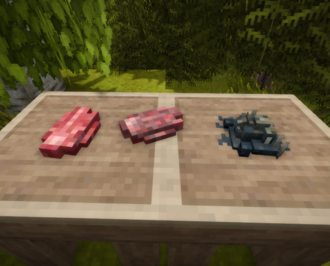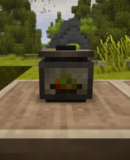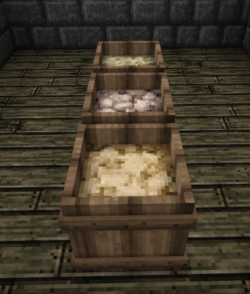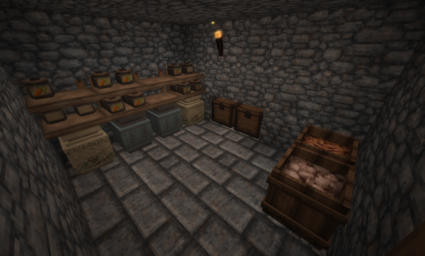Préservation des aliments
Cette page a été vérifiée pour la dernière fois pour Vintage Story avec la version 1.15.10.
La plupart des aliments ont un temps de péremption, ce qui signifie qu'ils se gâtent avec le temps, perdent leur valeur nutritive et finissent par se transformer en pourriture. Pour lutter contre ce phénomène, il existe certaines méthodes de conservation permettant de garder vos aliments frais, comme les conteneurs de stockage spéciaux et les celliers.
La nourriture pourrie à l'intérieur d'un récipient tel qu'un bol, un pot ou une marmite peut être retirée en la laissant tomber dans l'eau. Après quelques secondes, la pourriture remontera à la surface et se séparera du récipient. Les pots scellés contenant de la nourriture pourrie doivent d'abord être descellés, en prenant une portion de nourriture avec un bol.
Durée de conservation
Chaque type d'objet a un "temps de périssabilité" différent, qui se compose de son "temps de fraîcheur", qui est le temps nécessaire pour qu'un article frais commence à se détériorer, et de son "temps de détérioration", qui est le temps nécessaire pour que l'article se transforme en pourriture.
Lorsque vous combinez des piles d'aliments, leur temps de péremption global moyen devient le nouveau temps de péremption des deux aliments.
Plats cuisinés
Pour les aliments cuits, leur nouvelle durée de conservation dépend de la fraîcheur des ingrédients. Des ingrédients plus frais signifient une durée de conservation beaucoup plus longue. Si vous cuisinez avec un ingrédient partiellement avarié, le plat cuisiné le sera aussi.
Facteurs affectant la détérioration des aliments
Le temps de périssabilité d'un produit alimentaire peut être plus ou moins long en fonction de divers facteurs :
= Climat
Le climat dans lequel les aliments sont stockés influe sur leur taux de détérioration. Les climats chauds augmentent le taux jusqu'à 2.5x (250%) tandis que les climats froids peuvent réduire le taux jusqu'à 0.1x (10%). Seuls les climats au niveau de la mer sont pris en compte. Placer vos aliments tout en haut d'une montagne ne changera donc rien si le climat de la zone est chaud.
Il est tout de même possible d'annuler l'impact du climat en construisant un cellier.
Food type
Different types of foods have different lifetimes. As mentioned before, food items remain 100% fresh for a specific time period (shown in the tables above). After this time, food items begin to decay at a rate affected by storage containers, storage locations, and climate conditions. As food items decay, they lose nutrition value and will eventually become "rot". The food items with the highest perish time from each category are: Cured meat (meats), Pineapple (fruits), Soybean/Peanuts (vegetables), Flour (grain), and Waxed Cheddar Cheese (dairy).
Food preservation containers
While food can be stored in any stationary container, storage vessels are best for storing grains and vegetables. Storage vessels and crocks are fairly easy to make, requiring only clay. However to increase the shelf life of meats and vegetables, combining preserving methods with containers is best.
Crocks
Can hold up to 4 portions of meals or pickled vegetables can be stored in crocks providing a slight reduction in food decay, which is a good option for short term food storage. For long term storage, sealing the crocks with a lump of fat or beeswax above the crock in the crafting grid reduces decay by a factor of 10. Filled crocks may be carried in player inventories. For convenience you can build shelves that can hold up to 8 crocks at a time.
Storage Vessels
Any food item can be stored in vessels, which provide storage benefits to preserved foods as well as raw foods. These vessels are good options for short and long term food storage as they reduce decay 75% for veggies and 50% for grains.
Food preservation processes
Almost all types of food items can be stored in the form of cooked meals, but it’s not always practical to do so. For this, there’s special food processing methods that increase their lifespan significantly. Due to the different components in foods, there are various processes to preserve each type or category of food.
Jam
Making jam requires a cooking pot, a bucket, honey, and berries. By using a cooking pot, add a minimum of two berries and two units of honey to make jam. For the longest shelf life, jam should be stored in a sealed crock.
Salt curing
Curing meats requires a barrel, salt and the raw meat to preserve. Each unit of meat requires two units of salt, i.e. 32 meat = 64 salt. After adding the appropriate ingredients into the input slot of the barrel, the GUI will state the process yield. At this point the barrel must be sealed for 480 hours to complete the curing process.
Pickling
Pickling vegetables requires a barrel, a bucket, salt, water, and the vegetables to preserve. Water and salt are mixed in the barrel to make brine before adding the vegetables. Otherwise, the process of pickling is very similar to salt curing. Each vegetable or legume uses one unit of brine and the barrel must remain sealed for 336 hours. Once the food items are pickled or salt preserved, they can be stored in any stationary container, though storage vessels are best.
Cheese
Milk can be turned into cheese by processing it in several steps with pickled vegetables and salt in a barrel. See the cheesemaking section for more details.
Food preservation locations
See also Cellar.
To negate the impact of a warm climate, build a cellar. Cellars have a fixed temperature of 5°C or colder if the ambient temperature is lower, meaning you will only profit from a cellar if the outside temperature is higher than 8°C in the first place.
Recommendations
- Build the walls from soil, ceramic, or stone materials and keep door/trapdoor count low. It’s best to not use any doors/trapdoors, and instead use dirt or hay as full-block fillers. The less light inviting openings the cellar has, the better - additionally, doors do not count as a soil or stone block and thus lower the efficiency, even if they do not let in sunlight.
- Keep the sun light level inside the cellar low, as it can raise the temperature by up to 10°C, thus influencing spoilage rate. Artificial lights like lanterns, torches and oil lamps are fine. This means building a cellar underground can help reduce the entry of sunlight, but it doesn't give a bonus solely on the fact it’s underground. Cellars can be located above ground, as long as they are safe from the sun.
- Cellars should be no larger than 7x7x7 blocks inside. If the room exceeds these dimensions, it will not be recognized as a cellar. Only the direct walls count, the corner rows can be left out without affecting the room recognition.
- Once a cellar is created any food items may be placed on a shelf or inside containers. A typical cellar layout is filled with crocks on shelves, storage vessels, chests and barrels of pickled food. All items stored in the cellar will receive equal food decay reduction.
- Unlike other room types, cellars react sensitively to chiselled blocks, even if the full block face points inwards. In some cases, the game may be unable to correctly calculate a chiselled block and therefore let light get in through there. It is recommended to either use no chiselled blocks in the cellar at all, or to make sure that there is an additional, complete-block layer covering these chiselled blocks.
Remarque :
Les joueurs peuvent vérifier l'avantage du stockage en regardant le bloc d'informations HUD d'une étagère ou d'un conteneur. Il affichera quelque chose comme Vitesse de péremption de la nourriture stockée : 0,25x, ce qui signifie dans ce cas que la nourriture durera 4 fois plus longtemps. |
| Wiki Navigation | |
|---|---|
| Vintage Story | Guides • Foire aux questions (FAQ) • Vintage Story Original Soundtrack • Versions • Controls |
| Systèmes de jeu | Artisanat • Taille de pierre • Modelage d'argile • Forge • Cuisine • Température • Faim • Minage • Stabilité temporelle • Puissance mécanique • Commerce • Agriculture • Élevage |
| Le Monde | Création du monde • Biomes • Météo • Tempêtes temporelles |
| Objets | Outils • Armes • Armure • Vêtements • Sacs • Matériau • Nourriture |
| Blocs | Terrain • Plantes • Décoratifs • Éclairage • Fonctionnels • Minerai |
| Créatures | Entités hostiles • Animaux • PNJs • Joueurs |
| Miscellaneous | Liste des commandes client • Liste des commandes serveur • Creative Starter Guide • Bot System • How_to_use_WorldEdit • Caméra cinématique • Enregistrement de vidéos à taux variable • ServerBlockTicking |




